Zillow Business Model Canvas 2024
While Zillow revolutionized the real estate market by providing instant home valuations and listings at users’ fingertips, it simultaneously reshaped how people dream about, search for, and ultimately purchase their ideal homes. In this Zillow business model canvas, we will identify its customer segments, value proposition, revenue streams, channels, customer relationships, key activities, key resources, key partners, and cost structure.
Interesting fact!
The company once created a tongue-in-cheek “Living on Mars” page, complete with Martian property listings, as an April Fool’s Day prank.
Zillow Competitors
Realtor.com | Trulia | Redfin | Homes.com | Apartments.com | LoopNet | Movoto | Homesnap | Compass | Opendoor
Customer Segments – Zillow Business Model Canvas
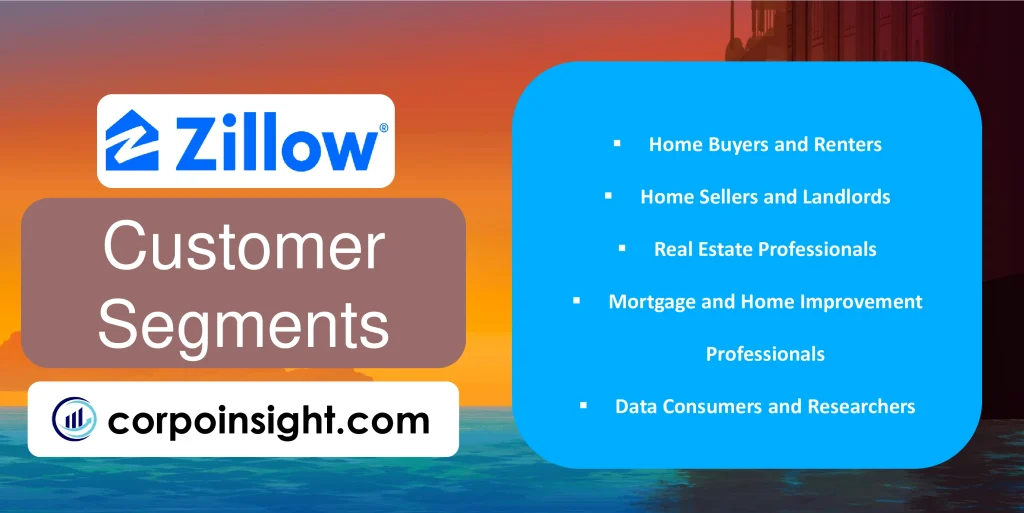
Home Buyers and Renters: Zillow caters to individuals and families seeking to purchase or rent properties, offering a vast database of listings that includes both residential and commercial real estate; this segment encompasses first-time buyers, those upgrading or downsizing, and people relocating for work or lifestyle changes.
Home Sellers and Landlords: Property owners looking to sell or rent out their real estate utilize Zillow’s platform to list their properties, leveraging the site’s extensive reach to connect with potential buyers or tenants; this segment includes individual homeowners, property investors, and real estate management companies.
Real Estate Professionals: Zillow serves as a crucial tool for real estate agents, brokers, and property managers who use the platform to list properties, generate leads, and enhance their online presence; the company’s “Premier Agent” program, which had over 150,000 participants as of 2023, exemplifies the importance of this segment.
Mortgage and Home Improvement Professionals: Expanding beyond its core real estate focus, Zillow has cultivated a segment of mortgage lenders, home improvement contractors, and other service providers who utilize the platform to connect with customers at critical stages of the home buying or renovation process.
Data Consumers and Researchers: Zillow’s vast repository of real estate data attracts a diverse group of professionals, including economists, urban planners, and market analysts, who rely on Zillow’s research reports and APIs to gain insights into housing trends and market dynamics.
Value Proposition – Zillow Business Model Canvas
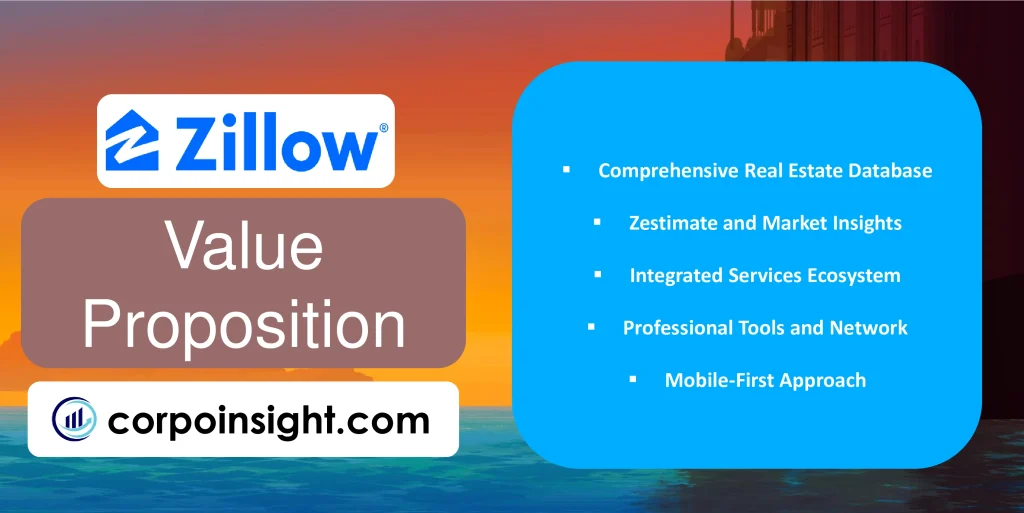
Comprehensive Real Estate Database: Zillow offers an extensive, up-to-date database of over 110 million U.S. homes, providing users with detailed information on properties for sale, rent, or even those not currently on the market; this vast repository of data, combined with user-friendly search tools, enables consumers to make informed decisions about real estate transactions.
Zestimate and Market Insights: The company’s proprietary Zestimate tool, which uses advanced algorithms to estimate home values, has become a widely referenced metric in the real estate industry; furthermore, Zillow’s market reports and forecasts, produced by its team of economists, offer valuable insights into housing trends and market dynamics.
Integrated Services Ecosystem: Zillow has evolved from a listing platform to a comprehensive real estate solutions provider, offering services such as Zillow Home Loans, Zillow Closing Services, and Zillow Offers (though the latter was discontinued in 2021); this integrated ecosystem aims to streamline the entire real estate transaction process for buyers, sellers, and renters.
Professional Tools and Network: For real estate professionals, Zillow provides a suite of tools and services, including the Premier Agent program, which connects agents with potential clients; additionally, the company’s acquisition of ShowingTime in 2021 has enhanced its ability to facilitate property showings and streamline agent workflows.
Mobile-First Approach: Recognizing the shift towards mobile usage, Zillow has heavily invested in its mobile applications, which accounted for more than two-thirds of the company’s traffic in recent years; these apps offer features like 3D home tours and instant notifications, catering to the on-the-go needs of modern real estate consumers.
Revenue Streams – Zillow Business Model Canvas
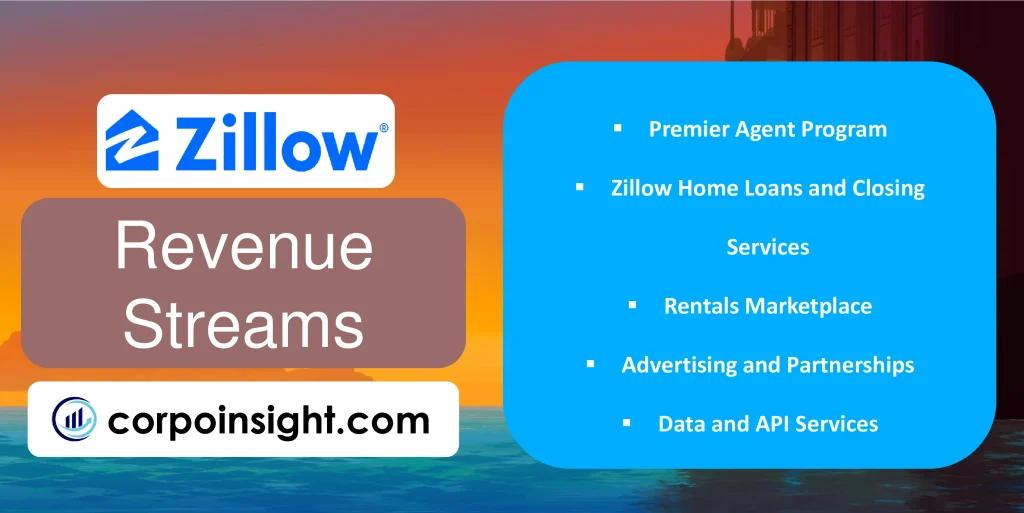
Premier Agent Program: This program, which allows real estate agents to advertise on Zillow’s platform and receive leads, remains a significant revenue source; in 2023, Zillow reported that Premier Agent contributed approximately 65% of the company’s total revenue, demonstrating the program’s continued importance despite market fluctuations.
Zillow Home Loans and Closing Services: Following its acquisition of Mortgage Lenders of America in 2018, Zillow has been expanding its mortgage origination business; while still a smaller portion of overall revenue, this segment, along with title and escrow services, has shown steady growth as Zillow aims to capture more value from each real estate transaction.
Rentals Marketplace: Zillow’s rental marketplace, which caters to individual landlords and large property management companies, has become an increasingly important revenue stream; the company charges fees for listing rentals and offers additional services to help landlords manage their properties more efficiently.
Advertising and Partnerships: Beyond real estate professionals, Zillow generates revenue through display advertising and partnerships with home improvement companies, moving services, and other businesses related to homeownership; this diversified approach helps Zillow monetize its substantial web traffic across various stages of the home journey.
Data and API Services: Leveraging its vast real estate database, Zillow offers data and API services to researchers, developers, and businesses; while not as prominent as other revenue streams, this segment capitalizes on Zillow’s unique position as a repository of comprehensive housing market information, providing a valuable resource for industry analysis and application development.
Channels – Zillow Business Model Canvas
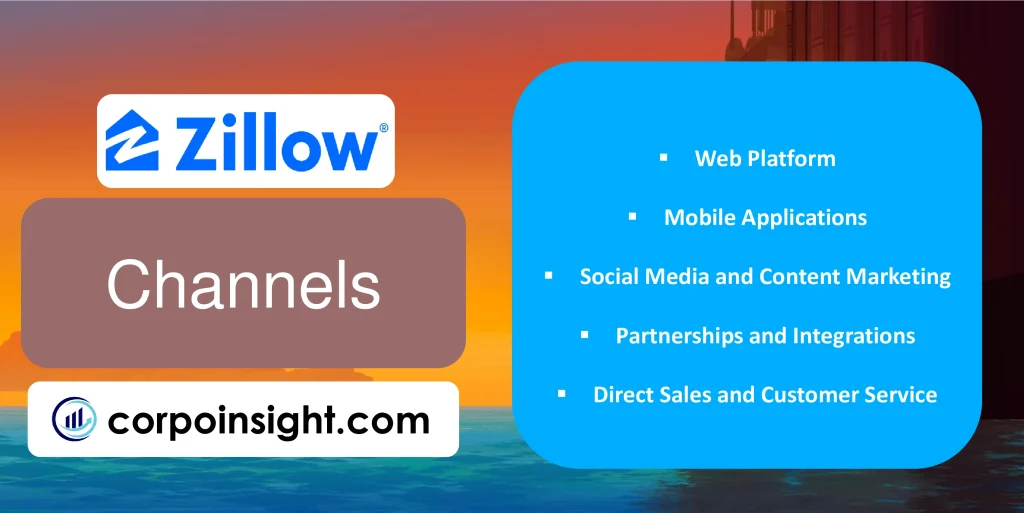
Web Platform: Zillow’s website remains a primary channel, offering a user-friendly interface for property searches, market insights, and tools like Zestimate; with over 200 million unique monthly visitors reported in 2023, the web platform continues to be a crucial touchpoint for consumers and professionals alike, facilitating property discovery and market research.
Mobile Applications: The company’s mobile-first approach has led to significant investment in its iOS and Android apps, which now account for more than 70% of Zillow’s total traffic; these apps, offering features like instant notifications and 3D home tours, cater to the on-the-go nature of modern real estate consumers and have become integral to Zillow’s user engagement strategy.
Social Media and Content Marketing: Zillow leverages various social media platforms and content marketing strategies to engage users and drive traffic; the company’s blog, research reports, and active presence on platforms like Instagram and TikTok not only provide valuable information but also help in building brand awareness and establishing Zillow as a thought leader in the real estate space.
Partnerships and Integrations: Zillow has established partnerships with multiple listing services (MLS), real estate brokerages, and other industry players to ensure comprehensive and up-to-date listings; furthermore, integrations with third-party services and APIs allow Zillow to extend its reach and provide a more seamless experience across various touchpoints in the real estate journey.
Direct Sales and Customer Service: For its Premier Agent program and other B2B services, Zillow employs a direct sales force and customer service team; this channel is crucial for maintaining relationships with real estate professionals, addressing their needs, and ensuring the effective use of Zillow’s tools and services, thus supporting a significant portion of the company’s revenue stream.
Customer Relationships – Zillow Business Model Canvas
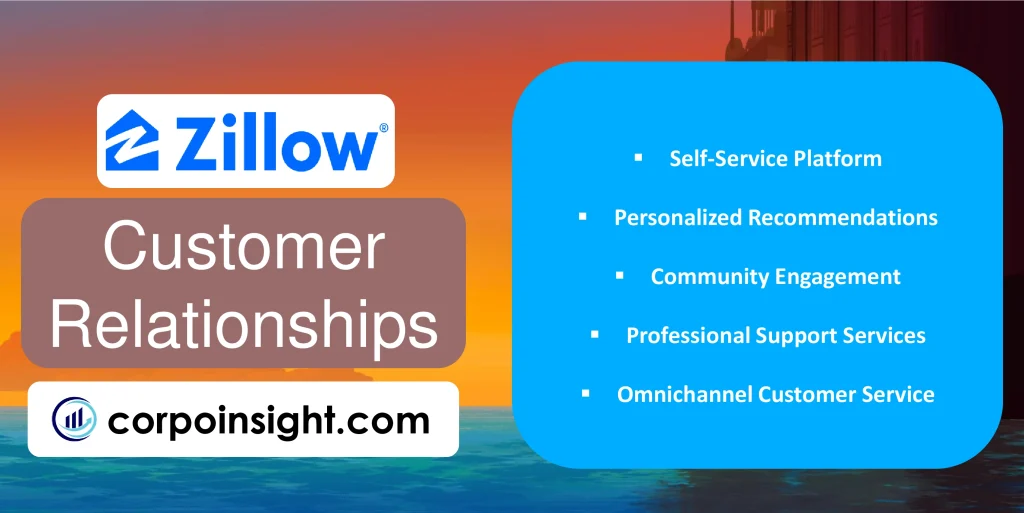
Self-Service Platform: Zillow’s primary relationship with consumers is through its self-service platform, where users can independently search for properties, access market insights, and utilize tools like Zestimate; this approach, which empowers users with information and autonomy, has been central to Zillow’s success and user engagement, with the platform reporting over 10 billion visits in 2023.
Personalized Recommendations: Leveraging artificial intelligence and machine learning algorithms, Zillow offers personalized property recommendations and insights to users based on their search history and preferences; this tailored approach, which has seen continuous refinement, aims to enhance user experience and increase the likelihood of successful matches between property seekers and available listings.
Community Engagement: Zillow fosters community engagement through features like user-generated content, including reviews of neighborhoods and real estate professionals; additionally, the company’s research team regularly publishes market reports and engages with the public through various media channels, positioning Zillow as not just a platform but a trusted source of real estate knowledge.
Professional Support Services: For real estate professionals using Zillow’s services, such as Premier Agent, the company provides dedicated support teams and resources; this B2B relationship management approach includes training programs, marketing tools, and customer service support, ensuring that professionals can effectively utilize Zillow’s platform to grow their businesses.
Omnichannel Customer Service: Recognizing the diverse needs of its user base, Zillow has implemented an omnichannel customer service approach, offering support through various channels including phone, email, chat, and social media; this strategy, which aims to provide timely and efficient assistance, has contributed to maintaining high customer satisfaction rates, with recent surveys indicating positive experiences for over 80% of users.
Key Activities – Zillow Business Model Canvas
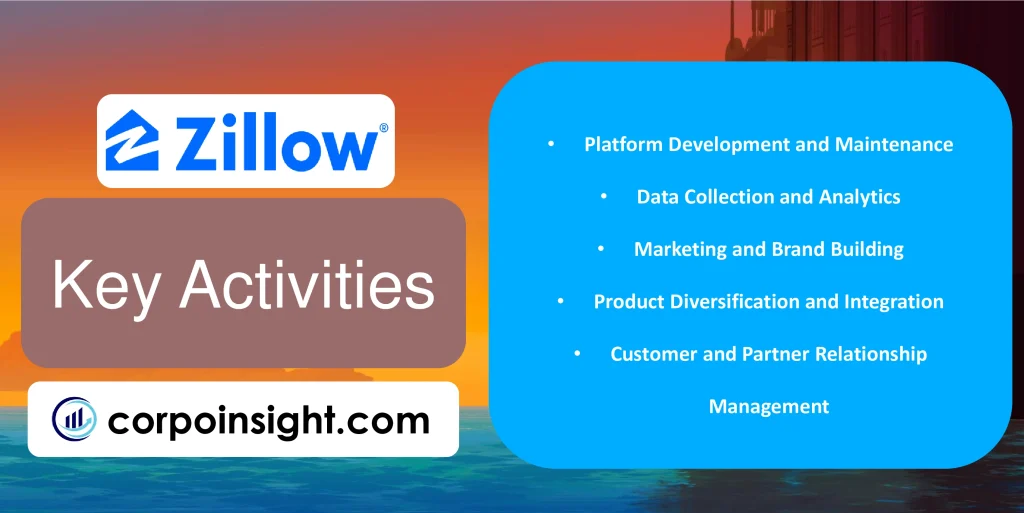
Platform Development and Maintenance: Zillow continually invests in enhancing its digital platform, which serves as the primary interface for millions of users; this ongoing development, which includes regular updates to both web and mobile applications, focuses on improving user experience, search functionality, and the integration of new features such as 3D home tours and AI-powered recommendations.
Data Collection and Analytics: At the core of Zillow’s operations is the extensive collection and analysis of real estate data, which powers its Zestimate tool and market insights; the company processes vast amounts of information daily, including property listings, public records, and user behavior data, to provide accurate valuations and market trends.
Marketing and Brand Building: Zillow engages in comprehensive marketing efforts to maintain its position as a leading real estate marketplace; these activities include digital advertising, content marketing through its blog and social media channels, and strategic partnerships with real estate professionals and industry organizations to expand its reach and reinforce its brand identity.
Product Diversification and Integration: In recent years, Zillow has focused on diversifying its product offerings beyond property listings, venturing into mortgage services, rental management tools, and closing services; this expansion, which aims to create a more comprehensive real estate ecosystem, involves developing new products and integrating them seamlessly into the existing platform.
Customer and Partner Relationship Management: Zillow dedicates significant resources to managing relationships with various stakeholders, including consumers, real estate professionals, and industry partners; this involves providing support services, educational resources, and tools for real estate agents through programs like Premier Agent, as well as maintaining partnerships with multiple listing services (MLS) to ensure comprehensive and up-to-date property information.
Key Resources – Zillow Business Model Canvas
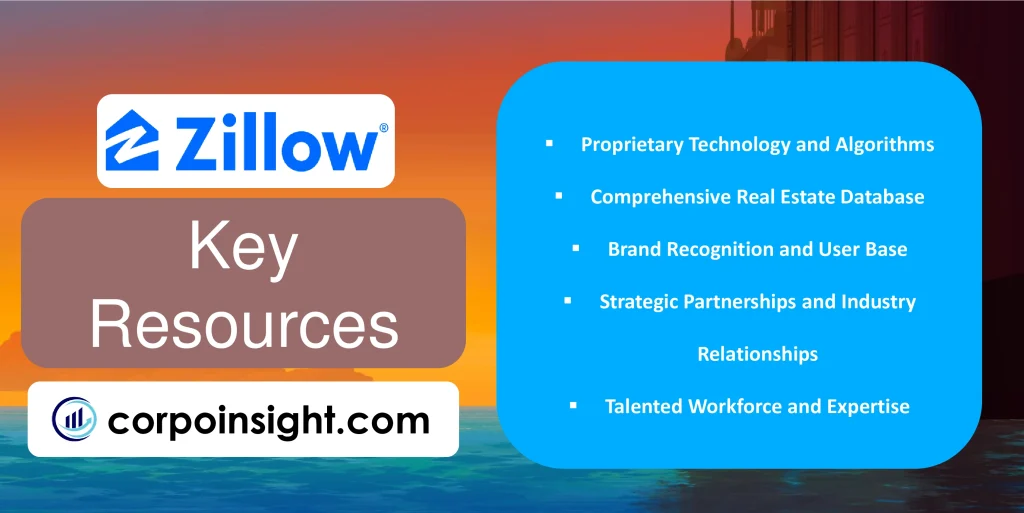
As a business analyst, I’ll analyze Zillow’s key resources based on recent data. Please note that my knowledge cutoff is April 2024, so some information may not reflect the very latest developments.
Proprietary Technology and Algorithms: Zillow’s cornerstone resource is its sophisticated technology stack, including the proprietary Zestimate algorithm, which processes data on over 110 million U.S. homes; this technology, continually refined through machine learning, not only provides home value estimates but also powers various features across the platform, contributing significantly to Zillow’s competitive edge in the real estate technology sector.
Comprehensive Real Estate Database: The company’s vast repository of real estate data, encompassing both on-market and off-market properties, serves as a critical resource; this database, which is constantly updated and expanded, underpins Zillow’s ability to provide accurate market insights, valuations, and trends, making it an indispensable tool for consumers and professionals alike.
Brand Recognition and User Base: Zillow’s strong brand presence and large user base, with over 200 million unique monthly visitors reported in 2023, represent a valuable intangible asset; this extensive reach not only attracts more listings and partnerships but also generates network effects, enhancing the platform’s value for all stakeholders in the real estate ecosystem.
Strategic Partnerships and Industry Relationships: The company’s extensive network of partnerships with real estate professionals, multiple listing services (MLS), and other industry players constitutes a key resource; these relationships, nurtured through programs like Premier Agent and data-sharing agreements, ensure a steady flow of listings and enhance Zillow’s credibility within the real estate sector.
Talented Workforce and Expertise: Zillow’s team of skilled professionals, including software engineers, data scientists, real estate economists, and market analysts, forms a crucial human resource; this diverse pool of talent, which has grown to over 5,000 employees as of 2023, drives innovation, maintains the platform’s technological edge, and produces valuable market insights that distinguish Zillow in the competitive real estate technology landscape.
Key Partners – Zillow Business Model Canvas
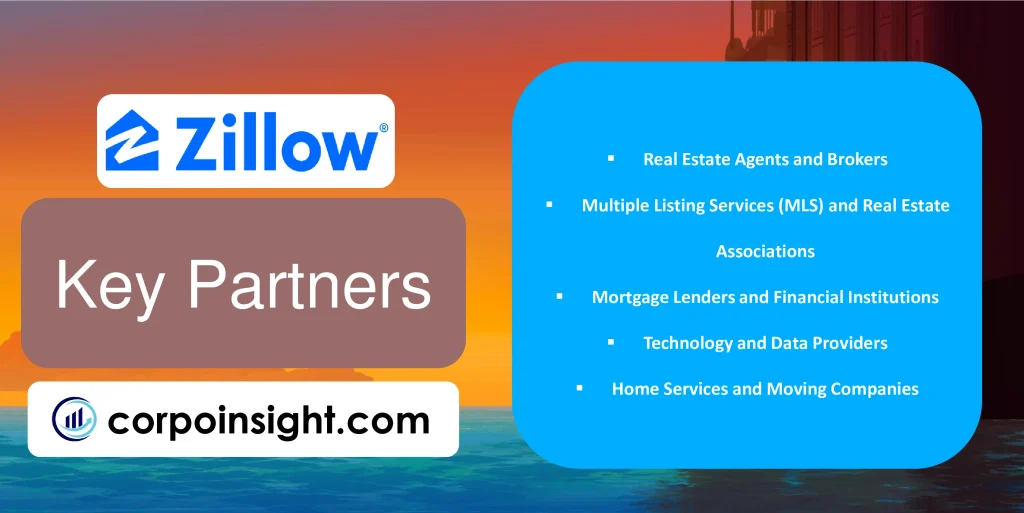
Real Estate Agents and Brokers: Zillow’s Premier Agent program, which had over 150,000 participants as of 2023, represents a crucial partnership with real estate professionals; this symbiotic relationship not only provides Zillow with a steady stream of listings and local market expertise but also offers agents a platform to connect with potential clients, thereby enhancing the overall ecosystem of the real estate marketplace.
Multiple Listing Services (MLS) and Real Estate Associations: Zillow maintains partnerships with numerous MLS organizations and real estate associations across the United States, which are vital for ensuring the accuracy and comprehensiveness of its property listings; these partnerships, while sometimes contentious due to data sharing concerns, are fundamental to Zillow’s ability to provide up-to-date and reliable information to its users.
Mortgage Lenders and Financial Institutions: In line with its expansion into mortgage services, Zillow has forged partnerships with various lenders and financial institutions; these collaborations, which have grown since the acquisition of Mortgage Lenders of America in 2018, enable Zillow to offer a more integrated home buying experience, providing users with access to competitive mortgage rates and streamlined application processes.
Technology and Data Providers: Zillow partners with various technology companies and data providers to enhance its services and maintain its competitive edge; these partnerships include collaborations with mapping services, AI and machine learning firms, and providers of public records and property data, all of which contribute to the robustness and accuracy of Zillow’s platform and its Zestimate algorithm.
Home Services and Moving Companies: To provide a comprehensive solution for homebuyers and sellers, Zillow has established partnerships with home service providers and moving companies; these alliances, which have expanded in recent years, allow Zillow to offer users additional services beyond property listings, such as home improvement estimates, moving assistance, and other related services, thereby creating a more holistic real estate experience.
Cost Structure – Zillow Business Model Canvas
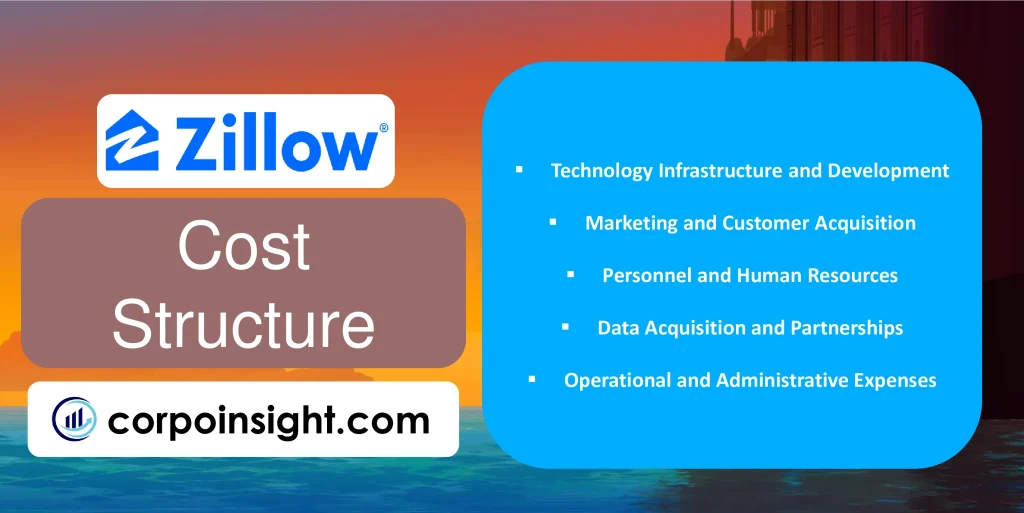
Technology Infrastructure and Development: A significant portion of Zillow’s costs is allocated to maintaining and enhancing its technological infrastructure, including data centers, cloud services, and software development; this investment, which reportedly exceeded $500 million in 2023, is crucial for supporting the platform’s vast user base and enabling the continuous improvement of features such as Zestimate and 3D home tours.
Marketing and Customer Acquisition: Zillow invests heavily in marketing to maintain its market position and attract new users, with expenses covering digital advertising, content creation, and brand partnerships; while the exact figure fluctuates, marketing costs typically represent 15-20% of the company’s total revenue, reflecting the competitive nature of the real estate technology sector and the importance of user growth to Zillow’s business model.
Personnel and Human Resources: As a technology-driven company, Zillow’s workforce represents a substantial cost, encompassing salaries, benefits, and stock-based compensation for its diverse team of engineers, data scientists, economists, and customer service representatives; in recent years, personnel costs have consistently accounted for approximately 40-45% of the company’s total operating expenses.
Data Acquisition and Partnerships: Maintaining comprehensive and up-to-date property information incurs significant costs for Zillow, including fees paid to multiple listing services (MLS), data providers, and other industry partners; while exact figures are not publicly disclosed, these costs are essential for ensuring the accuracy and breadth of Zillow’s property database, which is fundamental to its value proposition.
Operational and Administrative Expenses: Zillow’s operational costs encompass a wide range of expenses, including office leases, legal fees, insurance, and general administrative costs; additionally, as the company has expanded into new services like mortgage lending and closing services, it has incurred additional regulatory compliance costs and operational expenses related to these new business lines, contributing to a more complex cost structure.
Summary of Zillow Business Model Canvas

Conclusion on Zillow Business Model Canvas
Zillow’s business model canvas reveals a robust digital platform that has revolutionized the real estate industry. By leveraging advanced technology, extensive data, and strategic partnerships, Zillow offers value to consumers and professionals. Its diverse revenue streams, coupled with a focus on user experience and market insights, position it as a leader in the sector. However, maintaining a technological edge and navigating regulatory challenges remain crucial for sustaining its competitive advantage in the dynamic real estate market.

I’m Samin Yasar, currently working as a Brand Strategist for one of the world’s leading Prop Firms. I have a passion for content creation and dream of making my own film one day.







